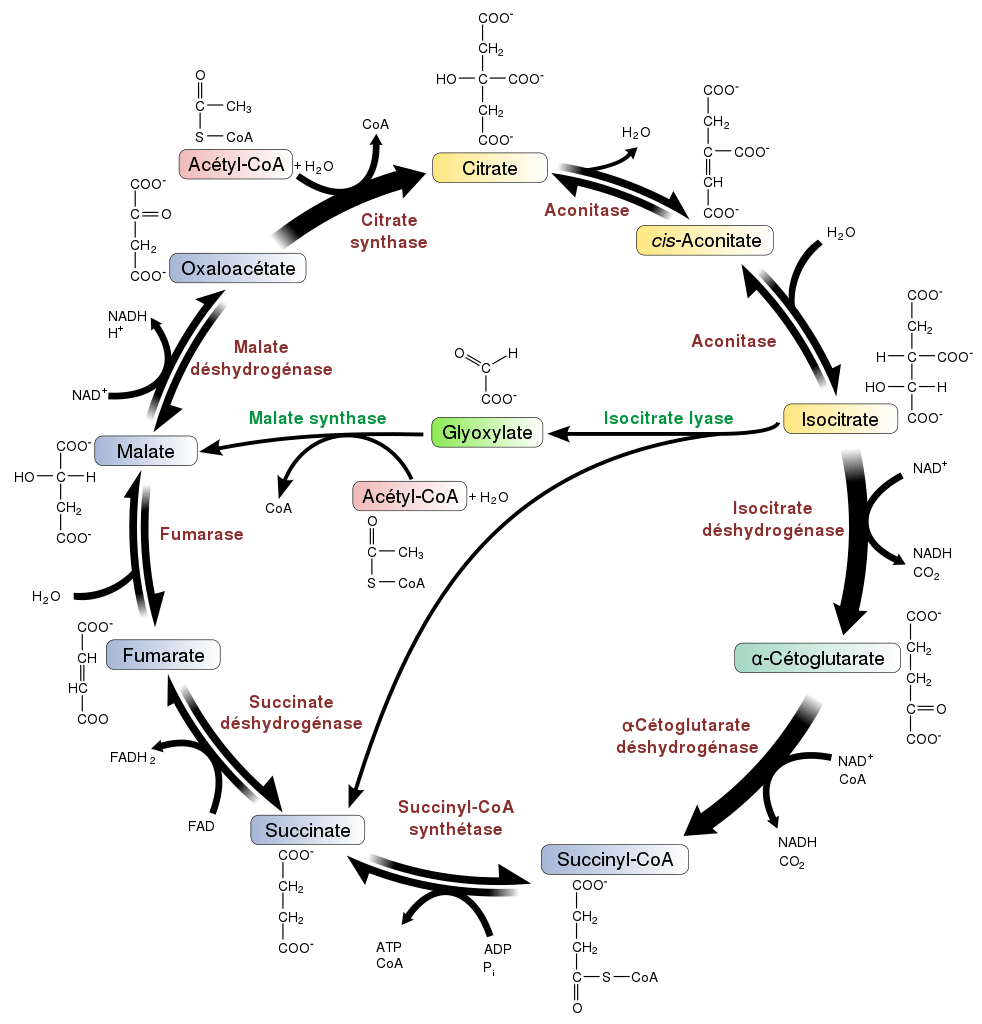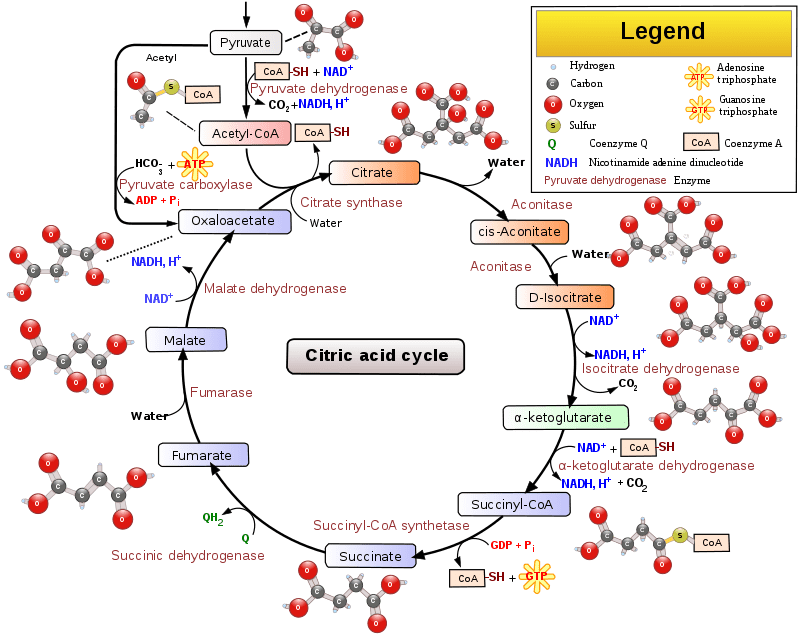What is the Difference Between Glyoxylate and TCA Cycle
Table of Contents
The key difference between glyoxylate and TCA cycle is that the glyoxylate cycle is an anabolic pathway where glucose is produced from fatty acids while the TCA cycle is a catabolic pathway that produces a considerable amount of energy to cells.
All living organisms require energy to maintain essential functions of the body. Humans and animals possess complex metabolic pathways since the energy requirement is high. But other organisms require limited quantities of energy. TCA cycle is the second stage of cellular respiration utilized by aerobic organisms to produce energy. The glyoxylate cycle is a variant of the TCA cycle present in plants, bacteria, fungi, and protists.
CONTENTS
1. Overview and Key Difference
2. What is Glyoxylate Cycle
3. What is TCA Cycle
4. Similarities – Glyoxylate and TCA Cycle
5. Glyoxylate vs TCA Cycle n in Tabular Form
6. Summary – Glyoxylate vs TCA Cycle
What is Glyoxylate Cycle?
The glyoxylic cycle is an anabolic pathway that occurs in plants, bacteria, fungi, and protists. This cycle is mainly based on the conversion of acetyl Co-A to succinate during carbohydrate synthesis. The main role of the glyoxylate cycle is to convert fatty acids into carbohydrates. The glyoxylate cycle enables the cells to use two carbon compounds like acetate to carry out cellular requirements during the absence of sugars such as glucose and fructose. The glyoxylate cycle is usually absent in animals; however, it takes place in the early stages of embryogenesis in nematodes.

Figure 01: Glyoxylate Cycle
The cycle functions with the use of five enzymes: citrate synthase, aconitase, succinate dehydrogenase, fumarase, and malate dehydrogenase. In plants, the glyoxylate cycle takes place in glyoxysomes. The seeds use lipids as the energy source during germination. Apart from lipids, plants also use acetate as a carbon and energy source. This cycle is also beneficial to induce plant defense mechanisms against pathogens such as fungi. The glyoxylate cycle performs a different function in fungi and bacteria. The cycle mainly takes place in pathogenic microbes. The main enzyme levels of the glyoxylate cycle increase upon contact with the human host. Therefore, the glyoxylate cycle plays a significant role in pathogenesis in microbes. Due to the role of the glyoxylate cycle in pathogenic fungi and bacteria, the enzymes are the targets for treatments in diseases.
What is TCA Cycle?
TCA cycle, also known as the citric acid cycle and Kreb’s cycle, is a series of enzymatic reactions that occur in aerobic organisms. The TCA cycle releases stored energy through the process of oxidation of acetyl Co-A, which is derived from carbohydrates, proteins, and fats. The name of this cycle is derived from citric acid, which is also a tricarboxylic acid consumed and regenerated through the sequence of reactions to complete the cycle. The TCA cycle consumes acetate and water, and acetate is consumed in the form of acetyl Co-A. In addition, it releases carbon dioxide at the end.

Figure 02: TCA Cycle
This cycle is carried out by eight enzymes: citrate synthase, aconitase, isocitrate dehydrogenase, alpha-ketoglutarate dehydrogenase, succinyl-CoA synthetase, succinate dehydrogenase, fumarase, and malate dehydrogenase. This cycle takes place in animals, plants, fungi, and bacteria. In eukaryotes, it takes place in the matrix of mitochondria, and in prokaryotes, it takes place in the cytosol. Carbon dioxide is released in the TCA cycle as a by-product. A glucose molecule is converted to acetyl Co-A prior to feeding into the cycle. The end products and intermediates of the TCA cycle are used up in lipid, amino acids, protein, and glucose metabolism.
What are the Similarities Between Glyoxylate and TCA Cycle?
- Five common enzymes, citrate synthase, aconitase, succinate dehydrogenase, fumarase, and malate dehydrogenase, are used in both cycles.
- Both cycles combine with acetyl Co-A to produce malate, which is catalyzed by malate synthase.
- Acetate is converted to acetyl CoA in both cycles.
- Both cycles are closed loops where the last part of the pathway regenerates the compound used in the first step.
What is the Difference Between Glyoxylate and TCA Cycle?
The key difference between glyoxylate and TCA cycle is that the glyoxylate cycle is an anabolic pathway while the TCA cycle is a catabolic pathway. In the glyoxylate cycle, the isocitrate is converted into succinate and glyoxylate by the enzyme isocitrate lyase instead of alpha-ketoglutarate in the TCA cycle.
The below infographic presents the differences between glyoxylate and TCA cycle in tabular form for side by side comparison.
Summary – Glyoxylate vs TCA Cycle
Energy requirements by different organisms vary with the complexity of the body. TCA cycle is the second stage of cellular respiration that undergoes a series of enzymatic reactions in the production of energy. The glyoxylate cycle is a special variant of the TCA cycle. This utilizes two carbon compounds in the absence of glucose. This is only found in plants, bacteria, fungi, and protists. TCA cycle consists of five enzyme-based reaction steps, and the glyoxylate cycle consists of eight enzyme-based reaction steps. Both cycles combine with acetyl Co-A to produce malate, which is catalyzed by malate synthase. So, this is the summary of the difference between glyoxylate and TCA cycle.
Reference:
1. “The Citric Acid (Krebs) Cycle.” Boundless microbiology. Lumen Learning.
2. “Glyoxylate cycle.” Science Direct.
Image Courtesy:
1. “Glyoxylate cycle-fr” By Original : Agrotman, vector version : Flappiefh – Glyoxylate cycle.jpg (CC BY-SA 3.0) via Commons Wikimedia
2. “Citric acid cycle with aconitate 2” By Narayanese, WikiUserPedia, YassineMrabet, TotoBaggins – (CC BY-SA 3.0) via Commons Wikimedia
ncG1vNJzZmivp6x7pbXFn5yrnZ6YsqOx07CcnqZemLyue9ahmK1lmah6tbTEZpuinpaav6a6wp5km52krLKmuoygo7KnqK65osDEZpinnF2psKJ5wrKapZ1f